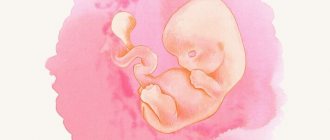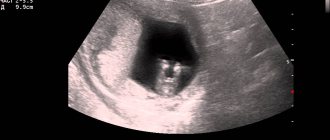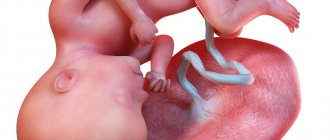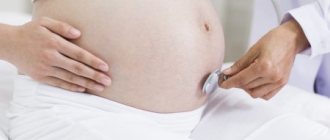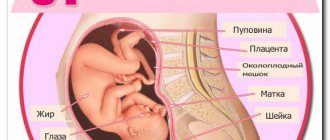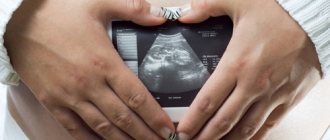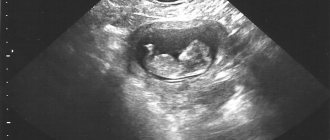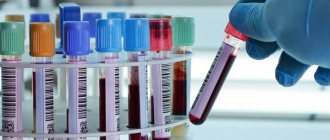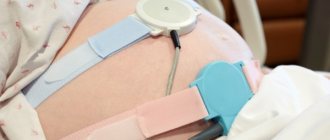The 23rd obstetric week is the 21st week from conception. If we consider normal months, then now you are at the beginning of the sixth month of expecting a baby.
By the 23rd week, the uterus is already raised 3.75 cm above the navel, and its height at the pubic symphysis is 23 cm. By this moment, the figure of the expectant mother has already noticeably rounded, the weight gain should reach from 5 to 6.7 kg .
Why is the study done and to whom is it recommended?
The 23rd week is a period when all organs of the fetus have almost formed, which means it is possible to make an accurate diagnosis of congenital malformations that are impossible to see on the first ultrasound. Identifying such defects is one of the most important tasks of research. The size of the fetus, all its systems, heart, kidneys and liver allows this to be done.
It is equally important to study the placenta and its condition: whether there are calcium deposits (calcifications) in its tissues, cysts that disrupt the functioning of the temporary organ, whether its size is normal. This will also allow you to decide on further tactics for managing your pregnancy.
Even during this period, it is necessary to evaluate the amniotic fluid (their quantity), because if there is little or too much of it, an unfavorable course of pregnancy is possible.
Reference! Based on the condition of the placenta and amniotic fluid, the risk of premature birth can be assessed.
It is at 22 and 23 weeks that the first signs of Rh conflict are revealed. It can be determined by an increase in the thickness of the placenta, by ascites in the fetus and by an enlargement of its head.
And finally, at week 23, most expectant mothers and fathers will find out the gender of the baby.
Important! Ultrasound at this stage is necessary for those women who, during the first examination, had a pathology (or suspected pathology) in the development of the fetus.
Feel
Fetal movements become more and more pronounced. If earlier you could still doubt whether it was the baby moving or the intestines working, now you can unmistakably recognize signals from the outside and sometimes you can even determine what exactly the baby is doing: he is playing, rolling over, or perhaps hiccupping. The baby’s movements give the mother a lot of joy until he kicks her in the ribs, but what is of little joy is that the peak of his activity occurs in the evening and at night, when the woman is trying to sleep. If the baby is very excited, try to lull him to sleep: sing a lullaby, stroke his tummy.
A growing belly will cause more and more discomfort every week: it is very likely that heartburn will appear. If the problem has already manifested itself, then start looking for your own “cure” for the internal fire. Some people save themselves with seeds, some with milk, and for others, a cube of chocolate helps. Just remember that you can’t extinguish heartburn with soda, and you shouldn’t: it will only intensify the burning sensation and make attacks more frequent.
The older the baby grows, the harder it will be for the mother to breathe. The uterus props up the sternum and compresses the lungs, preventing them from functioning normally. This is not scary, but it is important to learn how to get oxygen for yourself and your little one. Start learning different breathing techniques that will help you in the future during childbirth.
The bladder is also under increasing pressure, so trips to the toilet will become more frequent. To prevent them from interfering with your night's rest, try to limit your fluid intake after 6 pm. But drink enough throughout the day: if you experience swelling, it is not due to drinking. A slight swelling is physiological at such a time, since additional fluid is necessary to nourish the placenta. But if the swelling is too severe, then it is necessary to significantly limit the consumption of salt and salty foods. In any case, pay attention to this and try to avoid excess salt in your food. Among the new pregnancy companions, you may be surprised by the redness of your hands, but this is also a temporary phenomenon, which is to blame for hormonal fluctuations.
While time still allows, devote it to yourself, your beloved. Moreover, often in the second half of pregnancy, a woman’s skin needs special care: it dries out, can peel off, and overstretch, so do not forget about preventing stretch marks and daily moisturizing the skin.
Maintain hygiene in everything. This is also especially true for the breasts (you may notice colostrum leaking from the nipples) and the mouth (dental health often worsens during this period due to high calcium consumption).
Mother's condition and fetal development
At the 23rd week of development, the fetus actively and freely moves in the uterus, somersaults and kicks with its arms and legs. The baby is gaining fat, but it is not very noticeable due to the fact that the skin is formed early.
There are other notable changes:
- The baby’s digestive system is almost ready for work, so he swallows up to half a liter of amniotic fluid per day and excretes it in the urine. The baby is actively accumulating meconium.
- The central nervous system develops no less actively. If you examine a baby’s brain using special instruments, you will find that its activity is almost the same as that of a newborn or even an adult. Now the baby is seeing the first dreams in his life. The brain has a mass of 24 grams, but this is ten times more than three months ago.
- His eyes are open, he already perfectly distinguishes between darkness and light, and reacts to them. Hearing is also fully developed, so the baby reacts to all sounds.
There are not very many changes in my mother’s body. As the uterus grows, it displaces all the organs, which can cause discomfort. Among the main problems of this period are back pain, heartburn, increased urination and constipation.
Reference! At this stage, miscarriage is no longer possible, only premature birth is possible, after which the baby can be viable.
Feelings of a pregnant woman at 23 weeks
The 23rd week of pregnancy is a fairly favorable period for almost all pregnant women. In most cases, women feel good. When this week goes by, almost all the woman’s sensations are focused on the baby, because now she constantly feels him. Most often, at week 23, women experience the following sensations:
- Braxton-Hicks contractions . In principle, they may not exist yet, but this is a very common occurrence. Contractions appear in the form of slight spasms in the uterus, do not worry, they are part of its preparation for future childbirth. If you place your hand on your abdominal wall, you may feel previously unfamiliar muscle contractions. These are the muscles of your uterus trying their hand. In the future, such contractions may begin to intensify. However, Braxton Hicks contractions should not be confused with true labor contractions;
- Weight increases noticeably . The fact is that your uterus continues to grow, along with it the placenta grows and the volume of amniotic fluid increases. Some friends may notice that your belly has grown too much and assume that you are having twins. Or, perhaps, they will tell you that your stomach is too small for such a period. The main thing is not to panic, all children develop differently, so you shouldn’t listen to anyone, most likely everything is fine with you;
- Pain with uncomfortable body position . At this stage, the baby is already kicking very noticeably, sometimes he can hiccup and change his location in the uterus at least 5 times a day. Because of this, you may experience nagging pain. Also, it can be sharp, it appears on the sides of the uterus and arises from tension in its ligaments. The pain quickly goes away with a change in body position, and the uterus remains relaxed and soft. Some women, already at 23 weeks, may experience pain in the symphysis, the bony fusion of the pelvis in the pubic area, and their gait may also change slightly due to the divergence of the pelvic bones before future births;
- There is a feeling of heaviness in the legs and swelling , and pain may occur. You may notice that your old shoes are a little tight, this is quite normal. Due to weight gain and sprained ligaments, the foot begins to lengthen and static flat feet develop. Special insoles for pregnant women and comfortable, stable shoes will help you cope with this problem;
- Varicose veins may appear . It is by the 23rd week that such an unpleasant phenomenon as varicose veins may appear. This is due to the fact that the wall of the veins relaxes under the influence of hormones, and the uterus, in turn, disrupts the outflow of blood through the veins due to compression of the pelvic veins;
- The appearance of hemorrhoids is likely . By this time it may appear along with constipation. Characteristic symptoms will be pain in the rectal area, prolapse of nodes, and bleeding. Do not self-medicate under any circumstances! Only a specialist can cure hemorrhoids in pregnant women; this is a very difficult task;
- Skin is sensitive to ultraviolet radiation . Due to high hormone levels, you should be careful when out in the sun. If you sunbathe now, you may end up with age spots;
- Pigmentation appears . Your nipples have darkened, a dark stripe has appeared on your tummy from the navel down, and now it is already quite bright;
- I'm worried about nausea . Its reason lies in the fact that the enlarged uterus compresses the bile ducts and interferes with normal digestion. If you feel nauseous after eating, try to take a knee-elbow position, this will make it a little easier. It is worth noting that this pose also benefits your kidneys. Thus, the outflow of urine improves.
Heartburn, which appears due to a weakening of the esophageal sphincter, can spoil the mood of a pregnant woman. Also, the physiological causes of heartburn are an increased concentration of hormones and a decrease in the volume of the stomach due to the pressure of the growing uterus. Of course, it is difficult for an expectant mother to influence these factors, but it is quite possible to adjust and balance her diet if desired.
The best ways to combat heartburn are easily digestible foods and healthy drinks, as well as split meals in small portions. A pregnant woman who experiences symptoms of heartburn should give up fatty and fried foods that provoke sphincter relaxation, coffee and soda, legumes and grapes.
What does ultrasound diagnostics show, what does the doctor look for?
By doing an ultrasound at week 23, you can see how the fetus moves: it can tumble and grab the umbilical cord with its hands, play with its legs and arms. Now not only are all of its organs actively developing, but the bone structure is also being formed. The claws on the fingers and hairs are clearly visible. Thanks to ultrasound devices, you can clearly hear the heart beating.
Important! If the number of beats exceeds 190 per minute, it is possible that the baby is oxygen starved.
It is now that the correct functioning of all organs and their sizes, the weight of the fetus, the length of its arms and legs, and the biological age of the baby are revealed. It is important to check whether all this corresponds to the timing of pregnancy. Now you can safely count the number of fingers on your legs and arms. And finally, at this stage the gender of the child is already determined.
The specialist should also examine the amniotic fluid and its volume, as well as the placenta.
But the main thing is to identify pathologies in fetal development. If abnormalities are found here, you should definitely see a geneticist. If you contact him on time and start treatment, there is a chance that the baby will be born completely healthy.
Recommendations and advice for the expectant mother
At week 23, you must definitely do an ultrasound , if you did not do this two weeks ago. Remember that if you do not pass this test now, then later it will be much more difficult to identify any pathologies of the fetus, if any. Naturally, you need to spend more time in the fresh air, eat healthy and balanced, and follow all the recommendations of your doctor.
- Attend an antenatal clinic once every two weeks . At the appointment, the perinatologist will assess the development, track the dynamics of the increase in abdominal volume and the height of the uterine fundus. Of course, the blood pressure and weight of the expectant mother, as well as the fetal heart rate, are measured. At each such appointment, the doctor examines the results of a general urine test of the pregnant woman, which she must take the day before the appointment;
- Move more, do not spend long periods of time sitting . If you still need to sit for a long time, for example, at your workplace, but get up from time to time, you can walk a little. You can also place a small bench under your feet, but for your workplace you need to choose a chair with a firm seat, a straight back and handrails. All these measures are aimed at avoiding congestion in the legs and pelvis;
- To prevent the development of hemorrhoids, include in your diet foods that are rich in coarse fiber , try to consume enough fluids and vitamins. In addition, it will be useful to lie on your side several times during the day and rest to relieve the veins in the pelvic area;
- Nutrition should take into account the tendency to heartburn and nausea, constipation . Try to eat as often as possible, avoid foods that can cause constipation and increase secretion of juices. If you gain weight easily by week 23, then be as careful as possible;
- Sex is becoming more and more restricted. By week 23, you are no longer as active as before, the choice of positions becomes increasingly limited, and some caution and forethought is required. However, sexual intercourse will benefit you. A woman needs to have an orgasm, and therefore positive emotions, which will undoubtedly affect the unborn baby.
What can be seen in the photo of the fetus?
Despite the active development of the fat layer, the baby will look wrinkled.
If the position of the fetus allows, then in the photo at 23 weeks you can see the scrotum in a boy and the ovaries in a girl.
Also in the picture you can clearly see the number of fingers and see the marigolds on them. The nose is clearly visible on the face; the child’s eyes, if he is not sleeping, will be open. The downy hair on the body and head begins to darken and this is also clearly visible.
Nutrition
Recommendations regarding nutrition at 23 weeks of pregnancy remain the same. It is important to ensure that the diet contains fats, carbohydrates and proteins with a predominance of the latter. Fresh vegetables and fruits in season are a must on the daily table; special preference should be given to the green gifts of nature.
Monitor the intake of calcium in the body, eat foods that increase hemoglobin, minimize salt intake and completely give up food chemicals and harmful delicacies: spicy, smoked, pickled, fried, and so on.
Be sure to drink enough liquid, for which purified living water is best suited. Fruit drinks, fresh juices and unsweetened compotes are also useful during pregnancy. Be extremely careful with herbs.
Speaking of sweets. If you really want to, treat yourself to dried fruits and simple nuts (no salt, sugar, unroasted), and even then carefully. You don’t need extra calories now - weight gain should be controlled very strictly. For the same reason, try to minimize your consumption of flour.
Examination standards
When performing an ultrasound at week 23, the specialist focuses on the following standards:
- the degree of maturity of the placenta is now zero;
- the number of respiratory movements is about 60 per minute;
- fruit size – approximately 26-30 cm;
- weight – from 500 gm to 520 gm;
- abdominal girth – from 16 to 20 cm;
- BPD (biparietal diameter) – from 52 to 64 mm (average – 59);
- transverse abdominal diameter – 56 mm;
- head circumference – 19 – 22.4 cm;
- fronto-occipital distance – from 67 to 81 mm;
- hip length – from 38 to 45 mm;
- shoulders – from 34 to 42 mm;
- radius - from 32 to 35 mm, ulna - from 29 to 37 mm, tibia - from 35 to 42 mm.
The norm for a pregnant woman should be:
- placenta thickness 23 mm;
- height of the day of the uterus is 23 cm.
Analyzes
Ultrasound is not the only examination that a pregnant woman is sent for. Throughout the entire period, she has to undergo many different biochemical tests, in particular a general blood and urine test, a test for sugar, blood clotting, hCG and determination of progesterone levels, and others.
Indicators of various markers can warn the gynecologist in advance about the development of undesirable processes in the body of his ward (in particular, exacerbation of genitourinary infections), as well as about possible complications in the development of the fetus. Causes for concern are the presence of protein and salts in the urine of a pregnant woman, elevated sugar levels, low or high levels of hCG, and a lack of progesterone in the woman’s blood.
Glucose testing is of particular importance now because it can indicate an increased risk of excess weight gain in the fetus. If the glucose level is too high, the expectant mother will be put on a diet and, possibly, will be prescribed specific treatment.
The hemoglobin level does not lose its relevance throughout pregnancy. Regular testing allows you to prevent and treat anemia, which is very often observed in pregnant women and is an unfavorable sign.
Remember that a single test cannot be the basis for making any diagnosis. Usually, pathology is indicated by poor results of both urine and blood tests at the same time. But in any case, it is necessary to take a second laboratory test to verify the results. Therefore, never make premature conclusions.
Pregnant woman's diet
The menu for the 23rd week of pregnancy is based on the principles of healthy eating. Eating “for two” is not at all necessary - it is important to eat not twice as much food, but twice as correctly.
- By the second trimester, the calorie content of the diet increases by 250-300 kcal in addition to the norm. This will be enough to replenish the increased energy demands for the mother and for the development of the baby’s body.
- A pregnant woman should focus on protein foods - during this period, even a slight protein deficiency can lead to undesirable consequences. You need to eat 200 g per day of meat, poultry, fish, seafood, cheese. If a woman eats eggs or cottage cheese during the day, then the total weight of protein products should be 250 g.
- The need for iron with the onset of pregnancy increases almost 3 times. Iron is necessary for the life support of the fetus, the normal functioning of the placenta, and its supply in the body is designed for blood loss during childbirth. This element is best absorbed when accompanied by vitamin C. Therefore, it is useful to eat a meat chop with a vegetable salad, and wash down a sandwich with boiled turkey with rosehip infusion.
Here's what a sample menu might look like for a 23rd pregnancy:
| Eating | Food and drink options |
| First breakfast | Oatmeal milk porridge with butter and banana, cheese sandwich, weak tea |
| Lunch | A serving of cottage cheese no higher than 2% fat, a glass of kefir 1% |
| Dinner | Stewed chicken fillet, salad of Chinese cabbage and herbs with sour cream, a slice of grain bread, dried fruit compote |
| Afternoon snack | Apple-carrot salad, dressed with 1 tbsp. vegetable oil |
| Dinner | Salmon baked in foil, potato stew, vegetable plate (tomatoes, cucumbers), pear, green tea |
| Before bedtime | A glass of fermented baked milk or kefir, juicer |
Norms of indicators
In addition to what the doctor tells you, you can compare your indicators in the ultrasound report with the norm yourself.
Standards of the studied indicators:
- Absence of uterine hypertonicity
- The position of the fetus is not transverse or oblique, but head up or head down
- Attachment of the placenta at a distance of at least 7 cm from the internal os of the uterus
- The length of the cervix is at least 3 cm
- Absence of suspended matter in the amniotic fluid, its moderate amount (absence of polyhydramnios and oligohydramnios)
- The degree of functional maturity of the placenta is zero
- Biparietal size of the fetal head – 56-59 mm
- Head circumference – 19-24 mm
- Chest diameter – 55-56 mm
- Abdominal volume – 16-20 mm
- Shoulder length – 34-42 mm
- Forearm length – 29-37 mm
- Thigh length – 38-42 mm
- Shin length – 35-42 mm
It will be much more informative if you conduct a Doppler examination of the fetus along with ultrasound. It will allow you to assess in detail the condition of the blood vessels and components of the cardiovascular system. Indicator standards:
- Uterine artery index – 0.36-0.68
- Umbilical cord artery index – 0.6-0.8
- Internal carotid artery index – 0.93-0.95
- Umbilical cord artery ratio – 3.4-3.6
- The value of blood flow in the fetal artery is 25.6-27.7
- Systole-diastolic ratio (SDR) of the uterine artery – 1.95
- SDO of the internal carotid artery – 0.94
- SDO inside the umbilical cord artery – 3.4-3.6
- The speed of blood flow in the child’s aorta is 25.6-27.7 cm/s
It is important to remember that this is a special case and individual characteristics of the body, so minor deviations from the norm are not always a pathology.
The entire period of pregnancy is associated with close communication with a gynecologist; if you have any concerns, be sure to consult with him.
